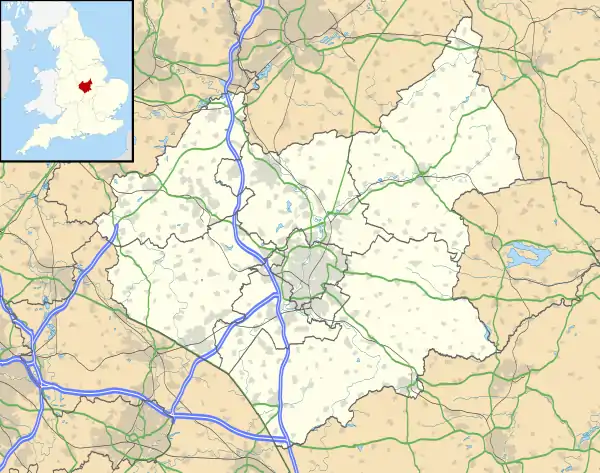Eastwell, Leicestershire
Eastwell is a village and ecclesiastical parish[1] in Leicestershire, England.
| Eastwell | |
|---|---|
 St Michael and All Angels, Eastwell | |
 Eastwell Location within Leicestershire | |
| District | |
| Shire county | |
| Region | |
| Country | England |
| Sovereign state | United Kingdom |
| Post town | Melton Mowbray |
| Postcode district | LE14 |
| Police | Leicestershire |
| Fire | Leicestershire |
| Ambulance | East Midlands |
| UK Parliament | |

For the purposes of administration Eastwell is part of the civil parish of Eaton that, in turn, forms part of the borough of Melton.[2] Eastwell lost its own civil parish status in 1936. Its population in 1931 was recorded as 152;[3] the 1851 census had recorded 158[4] so the village had not suffered the rural depopulation seen elsewhere.
Further back in time:
Eastwell is in the Hundred of Framland, 6 miles north by East from Melton; contains 1291 acres, 109 inhabitants and 24 acres. The sole proprietor is the duke of Rutland, who has a seat called Eastwell Hall. Lord Huntingtower is lord of the manor. The king is patron of the rectory, which has a glebe of 36 acres. The rector receives 85 pounds yearly in lieu of tithes.
— Curtis's History of Leicestershire. 1830[5]
Eastwell Church (St Michael) is built of ironstone. It dates mostly from the thirteenth century.[6]
From the early 14th century to the mid 16th century, Eastwell was the seat of one branch of the Brabazon family.
The Hall is a Grade II* listed building [7] It dates from 1634 but has windows and a front door altered in the nineteenth century.[8]
A new Eastwell Village Hall is being built.[9] It is scheduled for a mid-April opening.
Iron Ore quarrying
One factor which may have maintained the population was the extensive iron ore quarrying which took place in the western and southern parts of the parish. Quarrying began west of the road to Harby at the top of the scarp face. The quarrying began in 1881. The ore was taken down the scarp face by narrow-gauge tramway on a rope-worked incline to sidings on the Great Northern and London and North Western Joint Railway near Harby where it was loaded into railway wagons for transport to the iron works at Staveley, Derbyshire. As the quarries got further away from the incline the tramway was gradually extended.and from 1884 the tramway between the quarries and the incline top was worked by steam locomotives. Before that the wagons were pushed by hand or pulled by horses, the distance then being short. By 1913 the active quarries were either side of the Waltham Road close to the White Lodge. The tramway was then extended eastwards to serve new quarries at Eaton and Branston. Quarrying continued at Eastwell. The Eaton and Branston quarries that the tramway served closed in 1957. By 1959 the active quarry at Eastwell was on the south east side of the Scalford Road, west of the cross roads. The tramway was used only occasionally from then on and was taken up in 1961 and 1962. From 1959 the ore was taken by lorry to the railway sidings near Harby. The last quarry to be worked at Eastwell was on the east side of the Waltham Road, south of the White Lodge; it closed in 1967.
The quarrying was done by hand with the aid of explosives at first but steam diggers were introduced from 1915 and diesel machines from 1936.
As at 1988 some of the quarry buildings remained. The road bridge over the tramway at White Lodge was still there and quarry faces remained in two places east of the Waltham Road. Elsewhere the fields are smoothed over but sunken.[10] Two of the Eastwell Tramway locomotives survive, Lord Granby and Nancy in working order at the Cavan and Leitrim Railway.[11]
References
- Vision of Britain
- Council, Leicestershire County (30 January 2009). "Leicestershire Towns and Villages - Leicestershire County Council".
- Vision of Britain - detail
- GENUKI. "Genuki: 1851 Census Eastwell, Leicestershire, Leicestershire".
- GENUKI. "Genuki: Eastwell, Leicestershire".
- Pevsner, Nikolaus; Williamson, Elizabeth (1984). Leicestershire and Rutland. The Buildings of England (Second ed.). London: Penguin. pp. 148–9. ISBN 0-14-071018-3.
- Historic England. "THE HALL (1075025)". National Heritage List for England. Retrieved 17 November 2013.
- Buildings of England:Leicestershire and Rutland, Pevsner and Williamson.Page 148-9
- "Eastwell Village Hall, Leicestershire, UK".
- Tonks, Eric (1992). The Ironstone Quarries of the Midlands Part 9: Leicestershire. Cheltenham: Runpast Publishing. p. 111–145. ISBN 1-870-754-085.
- "One in, One out at Cavan & Leitrim as Nancy steams". Steam Railway. 26 April 2019.
External links
| Wikimedia Commons has media related to Eastwell, Leicestershire. |